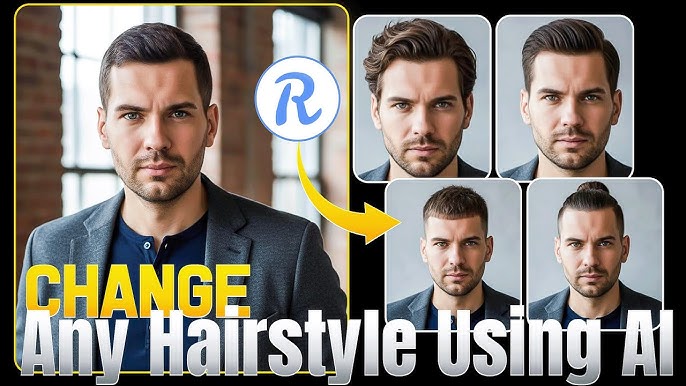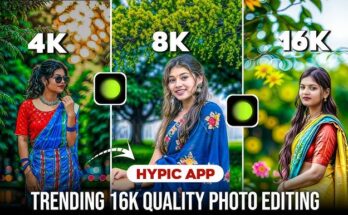Have you ever wondered how you’d look with a wildly different hairstyle — perhaps a short pixie cut, layered bob, or vibrant fantasy color — but felt too nervous to commit? Thanks to rapid advances in artificial intelligence (AI), you can now preview your new hairstyle virtually, right from your photo, before stepping foot in the salon.
In this comprehensive blog post, we’ll dive into how to change your hairstyle in a photo using AI: why it’s becoming popular, the technologies powering it, step-by-step how to do it (with different tools), tips to get realistic results, things to watch out for (privacy, realism, expectations), and ways to take it further (color, styling advice, bringing it to the real world). Whether you’re exploring a new look for fun, preparing for an event, or planning a major change, this guide has you covered.
Why Use AI to Try a New Hairstyle?
Changing one’s hairstyle can be exciting — but also risky. A salon appointment, time invested, cost of styling or color correction, waiting for hair to grow back if you dislike it — there’s real anxiety involved. AI hairstyle-preview tools solve many of these concerns.
Advantages
-
Risk-free experimentation: You can test bold haircuts or color changes without committing. For instance, one tool says you can “test drive a hair makeover without the salon drama, mirror shock, and risky permanent decisions.” getimg.ai+2AI Ease+2
-
Faster decision process: Upload a photo, pick a style, and within seconds see how you might look. AI Ease+1
-
Better communication with your stylist: Once you find a look you like, you can show that virtual version to your hairdresser to ensure you’re both on the same page. For example, one tool says: “Then bring the look to your barber with confidence.” AirBrush
-
Creative freedom: You can try styles you might never have dared in real life — dramatic cuts, fantasy colors, completely different textures — and see what suits you.
-
Save time and cost: By previewing and dismissing looks you don’t like, you avoid costly salon visits you may regret.
The Evolving Landscape of Hairstyle AI
Behind these tools lie ever-improving AI models: generative AI, inpainting, segmentation masks, pose invariance, etc. Academic research is pushing forward methods such as “pose-invariant hairstyle transfer” (so you can change hair even if your photo’s angle differs) arXiv+1. These advances translate to more realistic, credible hairstyle previews.
As one news article noted, AI image editing tools are reaching a state where they preserve a person’s likeness even when making dramatic changes like hairstyle or background. Tom’s Guide+1
Types of AI Hairstyle Tools and What They Can Do
Let’s break down what kinds of AI hairstyle-change tools exist, and what features to look for.
1. Template-Driven Hairstyle Changers
These let you upload your photo, then choose from a set of preset hairstyles (e.g., bob, pixie, curls). The AI applies the selected style to your image. For example, the tool at AI Hairstyle Changer ‑ Free Try‑on (via AI Ease) offers “80+ ready-made hairstyles … from sleek buzz cuts to bold dreadlocks.” AI Ease
Advantages: quick, easy, intuitive.
Limitations: your options are constrained to the presets; less customization.
2. Text-Prompt or Custom Mode Hairstyle Changers
Here you upload a photo and describe the hairstyle you want (e.g., “shoulder-length bob with side-swept bangs and caramel highlights”). The tool then uses AI to generate your look. For instance, one tool states: “Custom Mode: … describe your dream hairstyle in words and turn text prompts into a unique AI hairstyle.” AI Ease+1
Advantages: flexible, more personal; you can try unusual combinations.
Limitations: may require more tweaking; results vary based on prompt clarity.
3. Professional/Advanced Tools for Hair Transfer & Pose-Invariant Editing
These tools (less so consumer apps) use cutting-edge AI research to handle difficult cases — e.g., transferring a hairstyle from one image to another, dealing with pose changes, occlusion, etc. See papers like HairFIT: Pose‑Invariant Hairstyle Transfer via Flow‑based Hair Alignment and Semantic‑Region‑Aware Inpainting where the authors address changing long hair to short hair and how to fill in occluded regions. arXiv
This category underlies many of the consumer tools but is more “in the lab” than everyday apps.
Step-by-Step: How to Change Your Hairstyle in a Photo with AI
Here’s a practical, step-by-step workflow you can follow. We’ll cover both the general approach and specific tips to get the best result.
Step 1: Choose the Right Photo
-
Use a clear, well-lit front-facing selfie (or photo) where your face and current hair are clearly visible. One guide for usage of Photoshop with AI recommends: “Type in a description like ‘long hair’. … The AI will analyse the photo …” PHLEARN
-
Avoid heavy filters, extreme angles, huge shadows, or head tilts. The better the input, the more realistic and accurate the result. Many apps suggest this. For example: “The clearer your photo, the better your results will be.” Krea
-
Make sure your hairline is visible and your current hairstyle is somewhat standard — extreme occlusions (hair covering face, multiple people in frame) may reduce quality.
Step 2: Select the Tool / App
Pick one of the tools mentioned above. Here are a few to consider:
-
AI Hairstyle Changer – Free Try on Hairstyles (AI Ease) — online tool with 80+ styles. AI Ease
-
MyEdit AI Hairstyle Changer — simple interface: upload photo → change hairstyle. myedit.online
-
AILabTools Hairstyle Changer — good for both men and women. ailabtools.com
-
For advanced users: consider tools built on generative AI, or even use Photoshop’s generative fill with hairstyle change guides. PHLEARN
Step 3: Upload Your Photo and Set up the Parameters
-
Upload your chosen photo into the tool.
-
If prompted, select your face shape / hair type (some tools auto-detect).
-
Choose the hairstyle style you want to preview. If the tool offers custom mode / text prompt, you can describe your desired look (e.g., “shoulder-length wavy layers with balayage highlights”).
-
Choose any additional parameters: hair color, length, texture (straight, curly, wavy), accessories (bangs, fringe), hair volume, etc. Many tools highlight these options — e.g., custom mode in AI Ease lets you tweak color and style. AI Ease
Step 4: Generate and Review the Result
-
Click “Generate” or “Apply” in the tool.
-
Follow any on-screen instructions (some may ask to refine or select face/hair margin).
-
Once the transformation appears, critically review it:
-
Does the new hairstyle align naturally with your face and head shape?
-
Are the hairline, parting, shadows, and hair flow realistic?
-
Does the new look respect your identity (you should still recognise yourself)?
-
-
Some tools let you download the result or compare before/after. For example, getimg.ai emphasises: “See how different shades and tones will look on you …” getimg.ai
Step 5: Try Multiple Variations
-
Don’t stick to just one or two looks — experiment. Try short vs long, different textures, bold colors vs subtle ones.
-
Use the variation to decide what suits your face, lifestyle, personality.
-
Some tools allow iterative changes, or combining styles with color changes (e.g., text prompt “pixie cut platinum blonde with dark roots”).
Step 6: Choose & Prepare for Real Life
Once you’ve chosen a look you like virtually:
-
Save the generated image and bring it to your hair stylist/barber. It gives them a visual target.
-
Discuss with your stylist: Are you willing to commit to the maintenance for this style? What are the costs/time?
-
Ask: What adaptations are needed for your hair type (texture, thickness, growth pattern)? What color processes may be required?
-
Keep in mind: A virtual preview can differ slightly from real life because of factors like hair health, actual hairline, lighting, styling skills.
Tips to Get Realistic & Good Results
Here are important tips to make your AI hairstyle previews as realistic and useful as possible:
Choose the Right Lighting & Photo Quality
-
Use natural or soft lighting; avoid harsh overhead shadows.
-
Hair should be visible — side partings, face framing strands help the model.
-
Use a simple background so that the AI focuses on hair and not background distractions.
-
Ideally, one head and one face in the frame. Tools may struggle with multiple people.
Face Shape, Hair Texture & Your Real-World Hair Constraints
-
Know your face shape (oval, round, square, heart) — certain cuts look better on certain shapes. Some advanced tools even analyze your face shape. Tom’s Guide
-
Consider your actual hair texture (straight, wavy, curly, coily). A virtual straight style may look less plausible if your real hair is coarse and curly — plan realistically.
-
Consider your hair’s density, growth pattern, current length, and hairline. A drastic change (e.g., very short from very long) may require multiple salon visits or adjustments.
-
Consider your lifestyle and upkeep — a high-maintenance style (blond balayage, frequent trims) may not suit you even if you like how it looks. Use the AI preview as a decision tool, but pair with practical thinking.
Prompt Crafting (for custom mode)
-
Be specific: instead of “short haircut”, say “short pixie cut with side-swept bangs, platinum blonde” or “shoulder-length layered bob with soft waves, honey-brown highlights.”
-
Use descriptive adjectives: “sleek”, “textured”, “curly with fringe”, “fade haircut for men”, etc.
-
If color-changing, mention root shadows, highlights, undertones.
-
Review prompt results and refine after each run — many tools allow iterative refinement.
Review & Adjust for Realism
-
Check for hairline artifacts: sometimes AI adds unnatural hairlines or ignores partings.
-
Check for lighting mismatch: the new hair should match the lighting direction, shadow cast, and reflectivity of your original photo.
-
Check for skin/face identity: you should still look you. If the AI creates a different face or shape, it may be less useful for actual planning.
-
Do a side-by-side comparison: original vs modified — this helps you evaluate plausibility.
-
Sometimes, export multiple versions (“good”, “bold”, “safe”) to compare before deciding.
Consider Limitations & Expectation-Setting
-
Results are virtual previews: Real-world hair behaves differently (texture, thickness, movement).
-
Some complex styles (intricate up-dos, heavily voluminous curls, textured dreadlocks) may still challenge the AI models. For example, one article noted an AI struggled with up-dos. Tom’s Guide
-
Preservation of identity is improving but not perfect: older models sometimes distorted facial features. Newer ones make progress. Lifewire+1
-
Always factor in maintenance, cost, hair health (bleaching, colouring). The virtual version may look perfect, but hair might require repairs or upkeep.
Real-World Use Cases & Inspiration
Let’s look at scenarios where changing hairstyle in a photo with AI has real utility, and some creative ideas you might try.
Use Case 1: Big Life Event
-
Wedding, graduation, job interview, or a special occasion can be the perfect time for a hairstyle refresh. Use AI to preview looks so you feel confident.
-
For example: you’re attending a wedding and considering a formal up-do vs a sleek bob with waves — test both virtually and decide which aligns with your dress, theme, and face shape.
Use Case 2: Seasonal or Trend Refresh
-
Maybe you’re influenced by current hairstyle trends (e.g., curtain bangs, wolf cut, bleach blonde undercut). AI lets you test them without committing.
-
Example idea: Try a “wolf cut + forest green balayage” virtually, and if you like it, bring the image to your stylist as reference.
Use Case 3: Gender Affirmation / Identity Exploration
-
Hairstyle changes can be part of gender-affirming transitions or personal identity exploration. Virtual previews provide an empowering safe space to test.
-
You might try short buzz cuts, long hair extensions, or vivid colors to see how you feel before making a permanent change.
Use Case 4: Social Media / Branding
-
If you’re a creator, influencer, or professional whose appearance matters (e.g., actor, model, YouTuber), you might use AI hairstyle changes to test branding looks.
-
For instance: Try different hair colors / styles for a photoshoot, then choose the version that resonates most with your audience.
Use Case 5: Fun & Creative Exploration
-
Even if you’re not planning to change your real hair, AI hairstyle previews can be fun. Try fantasy hair colors, celebrity-inspired cuts, or futuristic styles, just for a laugh or avatar.
-
Example: “What if I had long silver hair with side braids?” — run the preview and share with friends.
How to Bring the AI Preview to Reality – Salon & Styling Tips
Once you’ve tested a look and chosen the one you like, here’s how to translate that into a real-life hairstyle.
Step 1: Bring the Image to Your Stylist
-
Show the AI-generated photo to your hairdresser/barber. It serves as a clear “look-we’re-going-for” reference.
-
Discuss with them:
-
Is your natural hair texture compatible with this look?
-
What processes will be required (cutting, colouring, highlighting, bleaching)?
-
What maintenance will this style entail (monthly trims? special products?).
-
-
Ask them to adapt the look to your face/head shape, hairline, and desired maintenance level.
Step 2: Plan the Transition
-
If you’re going from long to very short, or dark to very light color, you may need multiple visits.
-
Consider your hair health: If coloring/bleaching, make sure you have good hair condition (less breakage, strong strands).
-
Ask for a trial or transitional step: For example, maybe go medium length first or do a partial colour (balayage) before full bleaching.
Step 3: Maintenance & Styling
-
Ask your stylist for styling tips that match the look you liked. E.g., if you previewed beach waves, ask what tools/products to use.
-
Invest in quality products for the new style: heat protectant, curl-enhancing cream, hair mask for coloured hair, etc.
-
Plan realistic upkeep: some colors fade fast, cuts require regular trims, textured styles may need professional styling.
Step 4: Evaluate & Adjust
-
After the haircut/color, take photos in various lighting to compare how your real result matches the AI preview.
-
If you find differences (e.g., color slightly off, length not exact), discuss with your stylist and adjust in next visit.
-
Remember: the AI preview is a guide, not perfection — small real-life adjustments are natural.
Privacy, Ethics & Practical Considerations
While experimenting virtually is fun and useful, there are some important considerations to keep in mind.
Privacy & Data Security
-
When you upload your photo to online AI tools, check their privacy policy: How long do they store your image? Will it be used for other purposes?
-
Some tools claim to delete images promptly after use. For instance, one tool notes: “All uploaded images will be automatically deleted within 24 hours after processing is completed.” ailabtools.com
-
If you’re using a photo with identifying features (face clearly visible), ensure you are comfortable with how it’s processed or stored.
Realistic Expectations
-
The virtual hairstyle is a digital transformation — real hair may behave differently due to texture, lighting, movement.
-
Structural factors like hairline, skull shape, ear position, hair thickness affect how a style actually looks on you.
-
The AI may struggle with extreme styles, unusual lighting, multiple people in the photo, or occluded faces/hair. For example, up-dos or highly textured styles may not render perfectly. Tom’s Guide
-
Be aware of the cost/effort in real life: dramatic colour changes or cuts may require more upkeep than you expect.
Ethics & Authenticity
-
If you’re using these images for professional branding, ensure the final real-world look aligns closely. Misleading “before/after” illusions can cause trust issues.
-
Some AI-edited images may look unrealistic or flatten identity — be sure the final you still “looks like you”.
-
Transparency: If using this in social media marketing (e.g., influencer images), consider disclosing if an image was AI-generated or heavily edited.
Future Trends in AI Hairstyle Editing
The field is evolving rapidly. Here are some trends worth watching:
-
Improved realism & pose invariance: Research like “HairFastGAN: Realistic and Robust Hair Transfer with a Fast Encoder‑Based Approach” (2024) shows how AI is improving at transferring hairstyles even when the photo angle differs. arXiv
-
Multi-turn editing: Changing one thing at a time (hair first, then colour, then accessories) while preserving identity. News outlets report that tools are getting better at this. Tom’s Guide
-
Augmented Reality (AR) real-time preview: Instead of just static photos, you may soon preview new hairstyles live on your smartphone mirror mode, as some apps are starting to enable.
-
Integration with salon technology: Virtual hairstyle previews may link directly to salon booking systems, color/texture matching tools, or even virtual consultations with stylists.
-
Higher fidelity for challenging textures: More realistic curls, afro-textures, wavy hair, braids and more complex styles being better handled by AI (model training improves).
-
Ethical watermarking & identity preservation: Tools are beginning to embed watermarks or identity tags so users and viewers know the image has been AI-edited. Lifewire+1
Common Questions (FAQ)
Can I try a hairstyle without uploading my photo?
Some tools allow generic “model” previews or sample pictures, but the most accurate results come from your actual photo (face + hair visible).
Will the virtual hairstyle look exactly the same in real life?
Not exactly. The AI previews give a good approximation, but real-life outcome depends on your hair texture, density, growth direction, lighting, and styling skills. Use it as a guide, not a guarantee.
Are these tools free?
Many offer free versions or trial options (e.g., one tool mentions “Try for free” with no sign-up required) AI Ease+1 Some premium features (higher resolution, unlimited styles, export rights) may require payment.
Is my photo safe to upload?
It depends on the tool. Check their privacy policy. Some claim automatic deletion of uploaded images after a period. ailabtools.com However, always assume there is some risk when uploading identifying photos to third-party services.
What about men’s hairstyles?
Yes — many tools include men’s styles: fades, buzz cuts, man bun, crew cut, etc. For example, one service lists “free men hairstyle online” options. ailabtools.com+1
Can I change hair color too?
Absolutely. Many tools allow you to change both cut and color. For example: “Easily change the color of your hair with AI in under a minute.”
Prompts:
-
Buzz Cut
-
Crew Cut
-
Pompadour
-
Spiky Hair
-
Eboy Haircut
-
Modern Mullet
-
Bro Flow
-
Messy Fringe
-
Afro Fade
-
Pompadour Fade
SEO & Blogging Tips to Make This Post Stand Out
Since you’re aiming for an SEO-friendly blog post, here are a few tips to boost discoverability:
-
Use relevant keywords naturally: e.g., “AI hairstyle changer”, “try new haircut online”, “how to preview haircut with AI”, “virtual hairstyle try-on photo”, “change hair colour with AI”, etc.
-
Include long-tail phrases: “how to change your hairstyle in a photo with AI” (which is your main title), “best AI tools to preview hairstyle online”, “step by step virtual haircut preview”, etc.
-
Use headings (H2, H3) with keyword variations to structure the content (as we have done above).
-
Use images with alt-text (e.g., “woman using AI hairstyle changer to preview pixie cut”) and captions to enhance SEO.
-
Link internally (if you have other related posts) such as “best hair color for your skin tone” or “face shape haircuts guide”.
-
Provide external links or references to reputable tools or research (as I have included) to boost authority.
-
Encourage user engagement: ask readers to comment their results, share before/after, affiliate tool links (if applicable) for monetisation.
-
Make the article mobile-friendly, use bullet lists, steps, clear formatting — all help SEO readability.
Conclusion
Changing your hairstyle in a photo using AI is no longer a futuristic novelty—it’s an accessible, fun, and practical way to explore new looks, make confident decisions, and avoid salon surprises. By uploading a clear photo, choosing from preset styles or custom prompts, and reviewing the result realistically, you can preview what you might look like with a new cut or color.
Remember: the virtual preview is a guide, not a guarantee. Real-world factors (hair texture, face shape, lighting, styling) matter. But when used wisely, it empowers you to experiment, express your identity, and arrive at the salon prepared and confident.
So next time you’re considering a haircut, why not try it virtually first? It might just save you time, money, and styling regrets — and help you discover a look you never thought you’d love.
For More Information Visit



